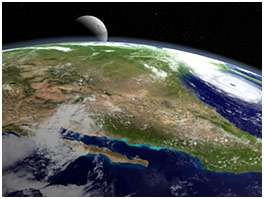February 17, 2012 report
Differences in tungsten isotopes show Earth surface formed unevenly

(PhysOrg.com) -- Many versions of early Earth history offer visions of a hot melting mix of materials which would have resulted, after cooling, in a smooth blend of ingredients, much a like a cake after beating and baking. New research from a trio of Geologists from the University of Maryland, suggests that such an image doesn’t correspond with evidence they’ve discovered in looking at tungsten isotopes in ancient lava rocks found in Russia. They note, as they point out in their paper published in Science, that differences in the amount of a certain type of tungsten isotope in that region differ from others in other parts of the world indicating that some parts of the Earth’s surface have been there longer than others.
The Earth came about, it is hypothesized, from other smaller bodies colliding and sticking together over the course of millions of years. As the Earth grew bigger, different pieces and parts shifted due to the amounts of iron in them. Eventually, the layers we see today formed. But before that, this new research suggests, there was a time when there was a lot of shifting going on as different parts of the surface were dragged down, and other parts thrust upwards. This can be shown, they say, by considering hafnium-182, (182Hf) an isotope believed to have existed during the time our solar system was forming. It is believed to decay to tungsten-182 (182W) over a period of approximately 60 million years and has been found to be more prevalent in the tungsten found in the lava rock in Russia than in the tungsten found in other places in the world, indicating that certain parts of Russia have been sitting in place longer than have other parts of the surface of the Earth, which upsets previous theories suggesting that the surface of the planet was once an even mix of materials.
The researchers also say this shows that the Earth developed its three current layers sometime over the course of the first sixty million years of the existence of our solar system and surprisingly, did so in a rather haphazard fashion. They believe some sections that remained fixed in place while others continued to shift and mix likely did so at least 2.8 billion years, ago, the approximate age of the rocks found in Russia.
More information: 182W Evidence for Long-Term Preservation of Early Mantle Differentiation Products, Science DOI: 10.1126/science.1216351
ABSTRACT
Late accretion, early mantle differentiation, and core-mantle interaction are processes that could have created subtle 182W isotopic heterogeneities within Earth's mantle. Tungsten isotopic data for 2.8 Ga Kostomuksha komatiites show a well-resolved 182W excess relative to modern terrestrial samples, whereas data for 3.5 Ga Komati komatiites show no excess. Combined 182W, 186,187Os, and 142,143Nd isotopic data indicate that the mantle source of the Kostomuksha komatiites included material from a primordial reservoir that represents either a deep mantle region that underwent metal-silicate equilibration, or a product of large-scale magmatic differentiation of the mantle. The preservation of this reservoir, likely formed within the first 30 Myr of solar system history, until at least 2.8 Ga, indicates that the mantle may have never been well mixed.
Journal information: Science
© 2011 PhysOrg.com



















